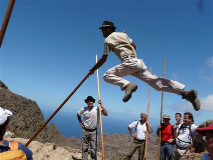Canary Islanders
Canary Islanders refer to the inhabitants of the Canary Islands, an archipelago located just off the northwest coast of mainland Africa. The islands are an autonomous community of Spain. The Canary Islanders, or Canarios, have a distinct identity shaped by the islands' geographical isolation, historical migration patterns, and cultural influences.
History[edit | edit source]
The original inhabitants of the Canary Islands were the Guanches, a Berber people from North Africa. The islands were known to the ancient Romans and were visited by Arab navigators in the Middle Ages. The Castilian conquest of the islands began in the 15th century, leading to significant cultural and demographic changes. The Canary Islands served as an important stopover for Spanish ships traveling to the Americas, which influenced the islands' culture and economy.
Culture[edit | edit source]
The culture of the Canary Islanders is a blend of Spanish, African, and Latin American influences. Traditional music, dance, and festivals, such as the Carnival of Santa Cruz de Tenerife, play a significant role in Canarian life. The islands are also known for their unique cuisine, which includes dishes such as papas arrugadas (wrinkled potatoes) with mojo sauce, and gofio, a type of flour made from toasted grains.
Language[edit | edit source]
The official language of the Canary Islands is Spanish, but the dialect spoken there has distinct characteristics, influenced by the Guanche language, as well as Portuguese and Latin American Spanish. This dialect is known as Canarian Spanish.
Economy[edit | edit source]
The economy of the Canary Islands is primarily based on tourism, agriculture, and fishing. The islands' pleasant climate and beautiful landscapes attract millions of visitors each year. Agriculture includes the cultivation of bananas, tomatoes, potatoes, and tropical fruits. The Canary Islands also have a growing renewable energy sector, particularly in wind and solar power.
Geography[edit | edit source]
The Canary Islands archipelago consists of seven main islands: Tenerife, Gran Canaria, Lanzarote, Fuerteventura, La Palma, La Gomera, and El Hierro. The islands are of volcanic origin, which has created diverse landscapes ranging from sandy beaches to rugged mountains and volcanic craters.
Demographics[edit | edit source]
As of the latest census, the Canary Islands have a population of over 2 million residents. The population is a mix of the descendants of the original Guanche inhabitants, Spaniards, and immigrants from Latin America, Africa, and other parts of Europe.
Challenges[edit | edit source]
The Canary Islands face several challenges, including environmental concerns such as water scarcity and the impact of climate change. The economy is also heavily dependent on tourism, which makes it vulnerable to global economic fluctuations.
Navigation: Wellness - Encyclopedia - Health topics - Disease Index - Drugs - World Directory - Gray's Anatomy - Keto diet - Recipes
Search WikiMD
Ad.Tired of being Overweight? Try W8MD's physician weight loss program.
Semaglutide (Ozempic / Wegovy and Tirzepatide (Mounjaro / Zepbound) available.
Advertise on WikiMD
WikiMD is not a substitute for professional medical advice. See full disclaimer.
Credits:Most images are courtesy of Wikimedia commons, and templates Wikipedia, licensed under CC BY SA or similar.Contributors: Prab R. Tumpati, MD





